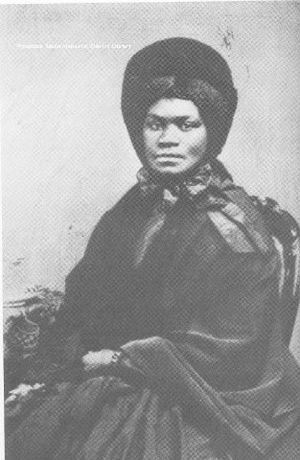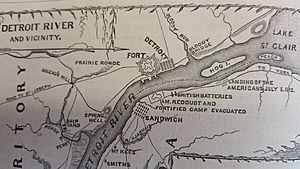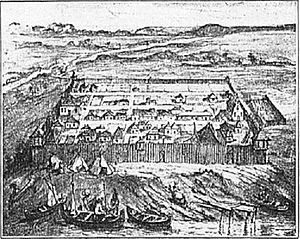History of slavery in Michigan facts for kids
The history of slavery in Michigan covers the time before 1865, when the Thirteenth Amendment to the United States Constitution officially ended slavery in the United States. This includes both the people who supported slavery and those who fought against it in Michigan.
Contents
Slavery in Michigan's Early Days
Slavery in Michigan started many centuries ago. Native American tribes sometimes captured enemies after battles. The French also began trading with Native Americans in the 1500s, and this included trading enslaved people.
When Detroit was founded in the early 1700s, records of enslaved people began to appear. These records are not complete, but one historian counted about 650 enslaved people in Detroit during the 1700s and early 1800s. This included 523 Native Americans and 127 Black people. Sadly, enslaved Native Americans lived for about 17 years on average, while enslaved Black people lived for about 25 years.
About 10% of Detroit's early population were indentured servants. These people worked for five to seven years to pay off their travel costs or debts. Even though they were free after their contract, their contracts could be bought and sold.
Native American Slavery Practices
When Native American tribes fought, the winners sometimes captured women and children. They brought them into their own communities. They also captured people to replace warriors who had died. These captured people were not always seen as property. They were sometimes used as gifts during trade or negotiations. Enslaved people were traded among different tribes. The children of enslaved Native Americans were not automatically born into slavery. After some time, some enslaved women could gain social acceptance and freedom. This practice of slavery might have existed for hundreds of years before Europeans arrived.
Slavery Under French Rule (1534–1763)
When the French came to what is now Michigan, they brought enslaved people with them. They also encouraged Native Americans to trade enslaved people. Most enslaved people in Michigan lived in Detroit or at the trading post near the Straits of Mackinac, which is now Mackinac Island. Slavery was present in Detroit from its founding in 1701. The settlement included Fort Ponchartrain, a trading post, and farms.
In 1709, the King of France made slavery legal with the Raudot Ordinance of 1709. Both French citizens and their enslaved people in New France were Roman Catholic. A law from 1724, called the Code Noir, required that enslaved people be educated and baptized. They had godparents who were free. Major life events for enslaved people, like birth and death, happened within the church. This meant that slaveholders did not have complete control over their enslaved workers. By 1750, about a quarter of Detroit's residents owned enslaved people.
Fur traders used enslaved Native Americans and African Americans for many tasks. They worked on boats, handled furs, grew food, cooked, and cleaned. About 25% of Detroit's population were enslaved workers. However, they produced half of the town's main products, such as beef, oats, and wheat.
Some fur traders who lived in the wilderness had enslaved Native American women as partners. Some of these women became interpreters or helped with trade. Some farmers owned enslaved people and worked alongside them.
John Askin, a fur trader in the 1700s, owned eight enslaved people. One enslaved woman, Monette, was Odawa.
Slavery Under British Rule (1763–1787)
British settlers also brought enslaved African Americans to Detroit. Some of these enslaved people came from slave markets in New York. Native American tribes sometimes attacked European settlements to protect their lands. They also captured enslaved African Americans. Native tribes often traveled with soldiers, and some officers owned enslaved people. In 1773, there were 73 enslaved people in Detroit. Nine years later, this number grew to 170.
During the American Revolutionary War, both free and enslaved Black people were asked to fight. Enslaved men who fought were often freed in return. They also received benefits for being veterans. Two Black Loyalists who fought with Butler's Rangers gained their freedom and received land near Detroit.
Slavery in the Northwest Territory (1787–1803)
Michigan became part of the Northwest Territory in 1787. The Northwest Ordinance of that year made slavery illegal, stating that "Neither slavery nor involuntary servitude shall exist in the territory." However, enslaved people still lived in Michigan until 1837. French and British slaveholders found ways around the law. The ordinance was understood to mean that no *new* enslaved people could be brought into the area.
The Jay Treaty between Great Britain and the United States made it illegal to buy and sell enslaved people. But this treaty did not change the status of the 300 enslaved people already living in Detroit in 1795. Catholic priests owned enslaved people, and an enslaved person helped build the Basilica of Sainte Anne de Détroit in 1800. Enslaved people played a role in building the city of Detroit.
Enslaved people usually slept on the kitchen floors of their slaveholders. In some cases, especially for families, they lived in a separate building.
Some enslaved people were hired out to others. This allowed them some freedom to move around the city. Some enslaved workers even married into the families of their slaveholders.
Elijah Brush was a slaveholder who also argued for an enslaved family's freedom. William Macomb, who owned Grosse Ile, owned 26 enslaved people. This was a very large number for the time. Other important Detroit families who owned enslaved people included the Campaus and Woodwards.
Slavery in Michigan Territory (1805–1837)
The number of enslaved people slowly decreased in the 1800s. Some owners voluntarily freed their enslaved workers. Enslaved people found safety with Michigan residents, in Canada, or by working along the Great Lakes. For example, John Askin's enslaved woman Madeline fled to work along the Great Lakes.
Feelings against slavery grew over time. By the 1800s, if a person crossed the border into Canada, they were free and would not be returned to slavery. People in Detroit would harass slave catchers who tried to find people who had escaped. In 1806, an overseer was illegally covered in tar and feathers. After Detroit's big fire in 1805, the plan to rebuild the city included giving land to free Black people and some enslaved Black people.

Some enslaved people filed freedom suits, or legal requests for freedom. But few won their freedom in court, even when it was clear they were enslaved illegally. One important case was In the Matter of Elizabeth Denison, Et. Al. in 1807. A farmer named William Tucker owned members of the African American Denison family. He said that Peter and Hannah should be freed after he and his wife died. But their children were willed to Tucker's brother's family. The Denisons started a lawsuit for the children's freedom, using the anti-slavery rules of the Northwest Ordinance. Judge Augustus Woodward and the Michigan Supreme Court decided that the children—Elizabeth, James, Scipio, and Peter Denison—should remain enslaved. The Denison family then crossed into Canada. Later, Judge Woodward ruled that enslaved people who became free by living in Canada would not be returned to Michigan Territory slaveholders. The daughter, Lisette, became a successful businesswoman and property owner. In the meantime, two people from Canada were freed in 1808 because of their freedom suits. The next year, a boy named Thomas and a woman named Hannah were also freed.
By 1810, there were 24 enslaved people in Michigan, with 17 of them in Detroit. Free and enslaved Black people were asked to fight during the Chesapeake Crisis and the War of 1812. This service freed the enslaved men from their bonds.
Mayor John R. Williams used enslaved people for forced labor. In 1817, Williams tried to buy two Native American teenagers. He planned to hold them as indentured servants until they were 30 years old. Even though there were known enslaved people in Michigan Territory in 1820, none were recorded in the census. The Detroit Free Press newspaper, started in 1831, supported slavery leading up to the Civil War.
After freeing themselves in Kentucky, Thornton and Lucie Blackburn arrived in Detroit in 1831. In 1833, free and enslaved Black people protested against the Blackburn family's imprisonment. This event is known as the Blackburn Riots. Protesters injured the sheriff while freeing the Blackburns and threatened to burn the city.
An enslaved woman named Rachel was held in Michigan Territory before being sold to a new slaveholder in Missouri Territory. In 1834, she filed a freedom suit called Rachel v. Walker. She lost in the first court but appealed to the Supreme Court of Missouri. She won her case and her freedom in 1836.
Slavery was banned throughout the British Empire, including Canada, by the Slavery Abolition Act 1833. Two years later, in 1835, there were only two enslaved people in Monroe County and one in Cass County. Slavery was officially banned in Michigan Territory in 1835 with its first Constitution of Michigan, just before it became a state in 1837.
The Anti-Slavery Movement in Michigan
In 1832, the first anti-slavery group in Michigan was started by a Quaker woman named Elizabeth Margaret Chandler in Adrian, Michigan. Laura Smith Haviland became a member of this group. The Michigan Anti-Slavery Society was founded in 1836 in Ann Arbor, Michigan.
George DeBaptiste was known as the "president" of the Detroit Underground Railroad. William Lambert was the "vice president" or "secretary," and Laura Smith Haviland was the "superintendent." The Second Baptist Church of Detroit, which was a stop on the Underground Railroad, was organized by African Americans in 1836. People seeking freedom often crossed the Detroit River into Canada.
Michigan became a state in 1837, and its Constitution of Michigan officially banned slavery. Henry Bibb, who had freed himself from slavery, moved to Michigan in 1842. He was the son of an enslaved woman and her master. He began to explain how enslaved people were treated in the South and encouraged them to "break your chains and fly for freedom."
In 1847, raiders from Kentucky came to Cass County and tried to kidnap at least nine formerly enslaved people. Adam Crosswhite and his family, who were formerly enslaved and living in Marshall, were among those they tried to capture. This event is known as the Marshall Crosswhite Affair. The Personal Liberty Act of 1855 was passed by Michigan's government. This law made it harder for enslaved people to be captured and returned to slavery. Sojourner Truth, a formerly enslaved woman and important abolitionist, moved to Battle Creek in 1857.
By the time Sojourner Truth moved to the Battle Creek area in 1857, she was a free woman. She had published her book, The Narrative of Sojourner Truth, and was a national speaker for both the anti-slavery and women's rights movements.
President Abraham Lincoln issued the Emancipation Proclamation in 1863. This document freed enslaved African Americans in the Confederate States. The First Michigan Colored Infantry Regiment was formed in 1864 to fight in the Civil War. Finally, the Thirteenth Amendment to the United States Constitution in 1865 banned slavery throughout the entire United States.
|



